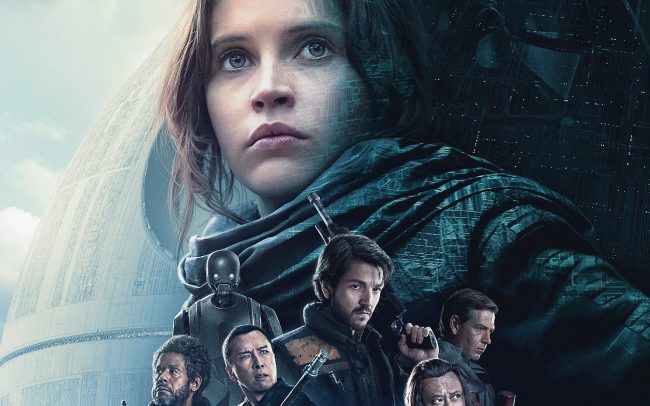Disney’s acquisition of LucasFilm ultimately led to a stellar return for the Star Wars film franchise in last year’s excellent Star Wars: The Force Awakens. With the direct follow-up to that movie still a year away however, we have another major test of the revitalized Star Wars brand on the big screen this year, as Disney begins their Star Wars Anthology plan with Rogue One: A Star Wars Story, or simply ‘Rogue One‘ outside of the marketing, a direct prequel to the original Star Wars: Episode IV – A New Hope from 1977.
Star Wars Anthology, along with the new Star Wars comic books published by fellow Disney subsidiary, Marvel, will replace the former pre-Disney ‘Star Wars Expanded Universe’ media that comprised the books, comics, video games, and various other media that LucasFilm had produced independently for the Star Wars franchise beforehand. No matter how beloved those stories and games may have been at the time, they’re now all entirely non-canon in the franchise’s official timeline of events. In layman’s terms, only the previous Star Wars movies, Marvel’s Star Wars comics, and the recent CG Star Wars cartoons actually happened in the franchise’s lore now. The rest didn’t.
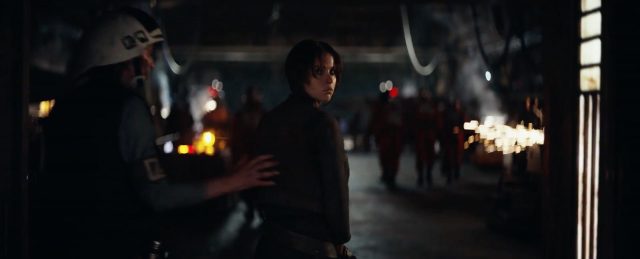
It’s a bold move by Disney to scrap the entire (and lengthy) catalogue of Star Wars Expanded Universe media, and one that definitely didn’t sit well with many longtime Star Wars fans. Fortunately, if you’re willing to look to the future however, Rogue One is nonetheless a worthy replacement spin-off, being another highly enjoyable, dramatic and satisfying new Star Wars movie, and one that actually manages to legitimately compare to The Force Awakens from last year, as well as the classic Star Wars trilogy. Being a spin-off, the movie is also a bit more experimental, namely by portraying a more intense and morally grey side of the Rebels-vs.-Empire conflict, and moving away from the legacy of the Jedi and The Force (mostly), to instead focus on a team of ordinary folks who are forced to fight without the aid of a Skywalker or a Kenobi.
This is a much darker and more harrowing Star Wars movie than any that has come before, though one that does stay firmly within its PG-13 rating, and doesn’t completely expend the humour and fun that helped to make The Force Awakens such a success last year. It’s a bit less family-friendly than the previous seven Star Wars movies, but Rogue One is nonetheless a powerful and gratifying movie that Star Wars fans and general moviegoers alike will love, and one that caps off Disney’s incredible hot streak in 2016 nigh on flawlessly.
In completely moving away from the ideas of the Jedi and the Dark Side, Rogue One brings us a new cast of characters to get behind, led by Felicity Jones’ Jyn Erso. Jyn’s father, Galen, played by Mads Mikkelsen, ends up separated from her at a young age, and taken to the Empire, leaving Jyn to instead be raised by Forest Whitaker’s Saw Gerrera. As a grown woman, Jyn then finds herself placed against her father’s legacy in the Rebel Alliance, which is about all I can say regarding Rogue One’s lead character without some significant spoilers. Also, no, Jyn has no connection to new Star Wars protagonist, Rey from The Force Awakens.
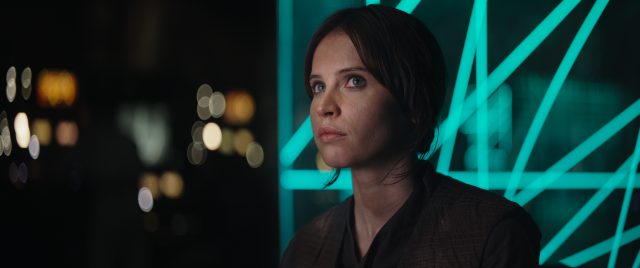
Jones headlines another impeccable Star Wars movie cast as Jyn, a brave, headstrong and genuinely rogue-ish lead that is easy to get behind, even when she initially has little interest in fighting for the Rebel Alliance. There isn’t too much of Whitaker or Mikkelsen in the movie by comparison, but they also deliver highlight performances as Jyn’s two highly separate father figures. It’s also through the characters of Saw and Galen that we see many added dimensions to both the Empire and the Rebels, something that no Star Wars movie has previously explored to this degree. With Galen being a good person that is forced to work for the Empire, and Saw provoking a less desirable element of the Rebels, we see a conflict that is no longer cut-and-dried the way it was in the classic trilogy. This alone makes Rogue One a very satisfying movie for Star Wars fans, as it allows them to re-interpret the franchise’s oldest conflict in a very fresh and exciting way.
Once Jyn does start the movie’s events proper, she finds herself complemented by an equally capable supporting cast. Diego Luna portrays Jyn’s begrudging comrade-in-arms, Cassian, a Rebel Intelligence Officer that initially sees Jyn as a liability, though is inevitably won over to her side in one of the movie’s more charming character arcs. Alan Tudyk is also a surprisingly big standout in the cast as K-2SO, a re-programmed Imperial Droid that joins Jyn and Cassian, whose snide, sarcastic and blunt personality is not only very humourous and entertaining, but essentially makes him a more capable version of iconic Droid worrywort, C-3PO.
Rounding out the ensemble is a defecting Imperial pilot, Bodhi Rook, played by Riz Ahmed, a heavy-hitting Rebel mercenary, Baze Malbus, played by Jiang Wen, and the movie’s lone Force-fueled character, Chirrut Imwe, played by Donnie Yen, a blind warrior that mostly fights with just a staff. All of these characters are given lovable personality traits that make them an effectively scrappy batch of unlikely heroes, and that makes their final resolutions all the more heartfelt, when they properly begin fighting back against the evil around them.
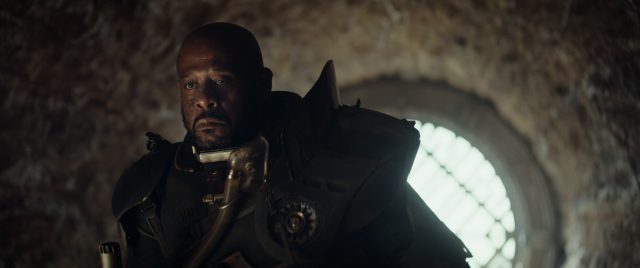
Regarding the movie’s villains, they’re a bit difficult to discuss, since even the movie’s lead antagonist constitutes a significant spoiler that was kept entirely out of the marketing. Ben Mendohlson portrays a villain called Orson Krennic, who is debuting in this movie, but even he can’t be discussed too much, beyond the Erso family having a personal stake with his Imperial research. I will say however that Star Wars fans will get a huge kick out of exactly who Jyn and her cohorts are up against most of all, with this foe representing one of the coolest uses of CGI in movies that you will have seen on the big screen all year. Some of the marketing did divulge another iconic Star Wars character that serves as a big villain in this movie as well, and if you already know who I’m talking about, then rest assured that he doesn’t disappoint, especially with his original voice actor reprising the role. You don’t see much of this particular bad guy, but you will enjoy what you see. It’s the icing on the cake of a cast that is easy to love, and in many ways, feels more human and relatable than any Star Wars movie that came before, even if they don’t lend themselves to many movies the way that Rey and Finn do.
Again, it’s difficult to discuss much of Rogue One’s storyline without spoiling several key turns in it. This is the kind of movie that Star Wars fans especially will want to know as little as possible about before going to see it, since there’s actually quite a bit of cool extension to classic Star Wars mythology. Most impressive is that this movie actually finds a really clever explanation for the biggest plot hole from the original Star Wars: Episode IV – A New Hope, which only goes to show how much clear effort has been put into making this first Star Wars Anthology offering truly count in expanding anew the revised Star Wars universe under Disney.
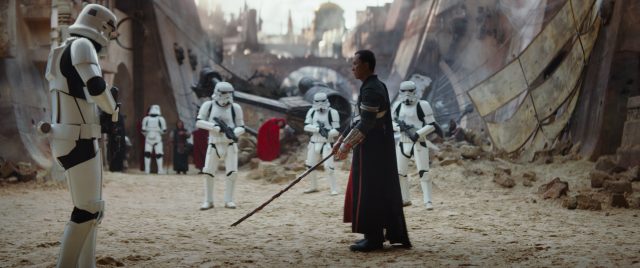
Without giving away key events, I can say that this movie’s storyline is constantly riveting, and much more grounded and human this time. The conflict itself is still quite fantastical, but there’s a very human feel to the story of Rogue One, which brings the series’ defining conflict into hair-raising, heart-wrenching reality. This movie more than anything before it represents the Star Wars franchise growing up and embracing the more sophisticated audience of a new generation. It even manages to deftly defy ‘Prequel Syndrome’ in most cases, managing to capitalize on events that Star Wars fans already know the outcome of, rather than feeling predictable and dragged down by them. At my screening, I heard someone tell me that Rogue One is the Star Wars prequel movie that this franchise actually deserves, and I think that really is an ideal way to put it.
(NOTE: The spoiler section, when clicked, discusses a few pivotal story turnouts, as well as how Rogue One connects to and fleshes out previous Star Wars movies.)
As the marketing indicated, Darth Vader also appears in Rogue One, complete with James Earl Jones reprising the voiceover role (contrary to rumour, Hayden Christensen does not physically portray Vader, who is instead portrayed by two separate body doubles), though his role in the movie is limited to cutting through Rebels and intimidating Imperials. Rogue One’s central villain is actually Grand Moff Tarkin, who was portrayed by the late Peter Cushing in Star Wars: Episode IV – A New Hope. Cushing’s likeness has been CG’d into the movie, with a soundalike voicing him, and while it’s a bit evident that Tarkin is a CG personality this time around, it’s pretty easy for the audience to forget that he’s an effect before long. As I said, resurrecting Cushing to posthumously return as Tarkin is a major marvel of CGI, and one of the most impressive character effects at the movies this year.
It’s also worth noting that a sequel to Rogue One is legitimately impossible, as director, Gareth Edwards stated in a recent interview, since every single lead protagonist actually ends up dying in the climax, including Jyn. This happens because of the movie’s key macguffin, which is actually the Death Star plans that Leia was attempting to flee with, and eventually hid within R2-D2, at the start of Star Wars: Episode IV – A New Hope. Jyn and her party were the ones that got the plans to Leia, and gave their lives to do so, as dialogue seemed to indicate in the original movie. This also ties in with one of the most noted plot holes of Star Wars: Episode IV – A New Hope, the obvious weakness of the Death Star, since Jyn’s father is the one who oversaw engineering of the Death Star, and deliberately designed it with a massive weakness for the Rebels to exploit, which the Imperials wouldn’t be able to detect, as revenge for the Empire killing his wife and driving away his daughter.
Gareth Edwards directs Rogue One, after helming 2014’s Hollywood-made Godzilla reboot, with Edwards once again successfully finding a palpable human touch in a larger-than-life conflict. Edwards is very good at conveying a sense of harrowing scale amidst improbable courage, and that makes him perfectly suited to directing a Star Wars movie like this one, which forsakes the fantasy in favour of the actual war.

The personalities in the movie are directed well, and nicely balance a sense of fun with a sense of drama. They don’t invite the same level of depth as the protagonists of the classic Star Wars trilogy or the more recent The Force Awakens, though perhaps that’s understandable, considering that Rogue One is a self-contained story that isn’t aiming to build sequels. The performances in the movie are nonetheless standout however, with each character becoming more likable as the movie goes on, all leading into a nicely intense climax that will put them all to the ultimate test.
As you can imagine, Edwards’ experience on his former monster-themed movies also lends itself very well to the movie’s action scenes. Much of the action is more aggressive and violent than previous Star Wars movies, as deadly weapons and tools of war are used at a grippingly earthbound level. You’ll still get a few battles between X-Wings and TIE Fighters here and there, but the real star of the directing comes from moments when ground troops battle amid these skirmishes on the ground level. Some of the most impressive shots involve infantry battles unfolding while AT-AT’s and AT-ST’s take on flying fighters above, while occasionally opening fire around the ground forces. The actual war of Star Wars has never felt more real than it does in Rogue One, which will put audiences into the most dangerous elements of battling the Empire like never before!
John Williams doesn’t score the music suite of Rogue One, though this also allows for a more experimental soundtrack to go with the more experimental story direction. Michael Giacchino composes the soundtrack of Rogue One, which occasionally brings in flourishes of the iconic John Williams themes from the mainline Star Wars movies, though mostly delivers new musical stylings. While the strings and crescendos that define a Star Wars soundtrack are still present, much of the score is heavier and more brooding, nicely representing a more uncertain time for the Rebel Alliance, as they start finding themselves losing to the Empire. That desperation makes for a Star Wars movie that sounds less outwardly upbeat, though one that also brings a more grounded take to the battle against the Empire, and it’s another winning soundtrack that Star Wars fans will likely want to own and listen to at their leisure.
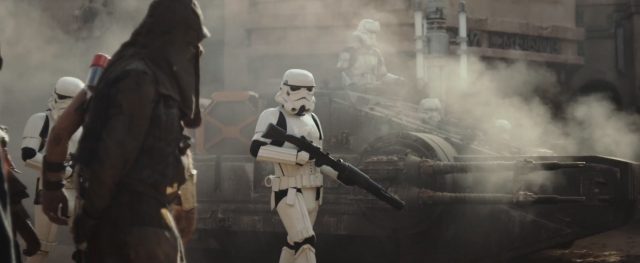
The rest of the audio work is also heavier and more powerful than past Star Wars movies, though naturally doesn’t forsake the iconic sounds that have come to define the brand. You’ll still hear the recognizable blaster shots and vehicle engines that have come to define the recognizable tools of Star Wars battle, though they’ve been given more bass this time, and sound both more explosive and more dangerous. This is captured especially well with the bigger war machines such as the AT-AT’s, or even the Death Star itself, which give even heavier, more pronounced groans and roars as they prepare their waves of destruction. Star Wars has never felt as imposing as it does in Rogue One, and those that want to take their Star Wars action to the next level definitely won’t be disappointed here!
This being a Star Wars movie, it’s pretty predictable that Rogue One offers one of the best selections of visuals out of any major movie release this year. The movie’s presentation doesn’t have quite the same incredible distinction as that of Doctor Strange from last month, another movie that came from the Disney umbrella, but Rogue One is nonetheless incredibly well-realized in terms of its visuals. The visuals aren’t quite as heavily polished as they are in the mainline Star Wars movies, but that’s kind of the point here. The weapons on display in Rogue One feel more crude and destructive, with more forceful explosions and brutal annihilation of the scenery and characters around them. That said however, the way that the movie provides extensive new freshness and modernization to recognizable weapons, personalities and crafts from Star Wars: Episode IV – A New Hope does an excellent job of highlighting just how far Star Wars has come since 1977.
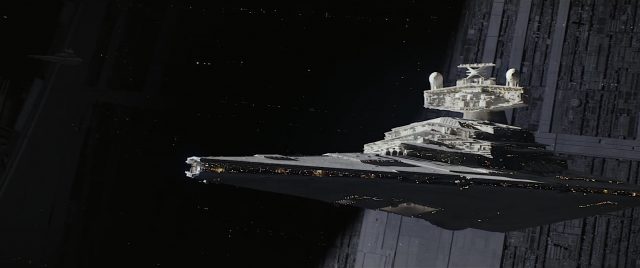
As great as the harrowing scale and intense action ends up being realized though, the premium formats are a bit more mixed, which was evident in my IMAX 3D screening. The 3D presentation is fairly subdued in a lot of scenes, adding surprisingly little to the movie’s action, though it’s put to much better use during the spacefaring scenes, and scale-driven scenes. The added atmosphere and immersion of the 3D makes a 3D ticket worth paying for at the very least, even if the 3D was definitely more engaging in The Force Awakens last year.
The IMAX 3D cut also makes pretty good use of the enhanced surround sound, making the war seem a bit more explosive and brash, though it’s disappointingly poorly-optimized for the IMAX screen. A standard digital 3D ticket for Rogue One will probably suit you just fine, and if you prefer to watch the movie flat in 2D, you don’t ultimately lose out on much that way either. Rogue One looks intentionally rougher and more rugged than the previous Star Wars movies, but it’s still visually arresting in its own right, in flipping the priorities from Force-powered fantasy to more unpredictable and uncompromising ground warfare.
Rogue One falls just shy of the same incredible high point of The Force Awakens, but it’s still easily the best Star Wars prequel movie to date, even being a spin-off, and still represents a fantastic start to Disney’s Star Wars Anthology initiative. The more grounded and human take on Star Wars lore is something that ended up being realized remarkably effectively, and this leads to action that is more gripping and stakes that are more pronounced in contrast to the mainline Star Wars movies that came before. The way that Rogue One is expertly leveraged to improve upon and further polish several muddier story elements of Star Wars: Episode IV – A New Hope is the best part of all!
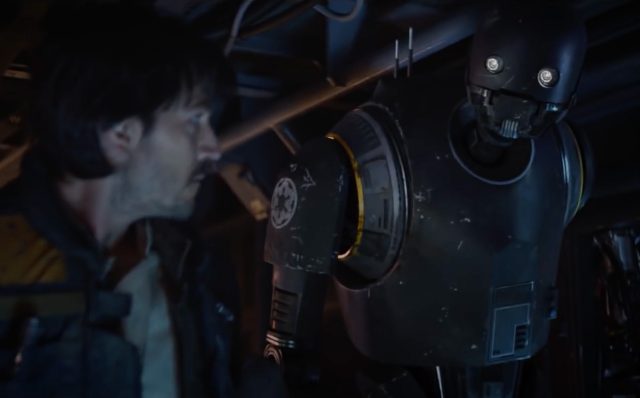
Even if it’s an offshoot movie that revolves around entirely new characters, and ones that aren’t quite as deep or memorable as the new lead cast from The Force Awakens at that, Rogue One is another excellent blockbuster that demands to be experienced in theatres this holiday season. It also paves the way for all sorts of potential regarding a new expanded universe for Star Wars. Both creatively and canonically, Rogue One proves that the Star Wars Anthology movies can still service the mainline offerings, without feeling like lesser siblings to them. Rogue One embraces the opportunity to attempt a new style that would never work in the mainline Star Wars movies, and that is a key ingredient to keeping the Star Wars universe fresh and exciting for many years to come.
Even in a closed, one-off storyline, the Star Wars movie franchise has never felt more rich or alive with possibility as it does after Rogue One. It’s yet another reason to look forward to the exciting contributions of cast and crew to come within the galaxy far, far away!

